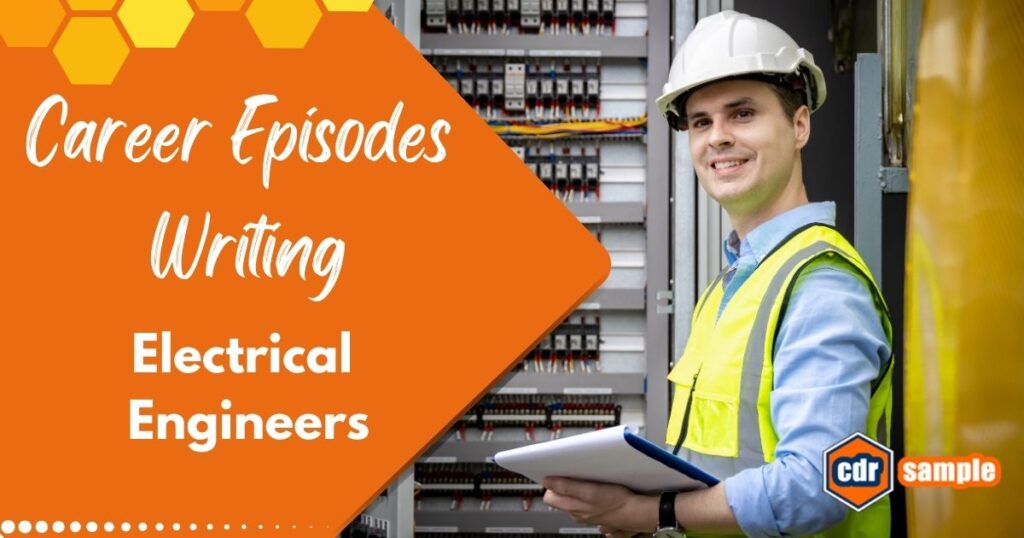How to Write Career Episodes for Electrical Engineer
We assume that before you came across this article, How to Write Career Episodes for Electrical Engineer for Migration Skills Assessment (or membership) purposes for Engineers Australia (EA), you already checked and selected the right ANZSCO code under which you would be applying.
ANZSCO code description for Electrical Engineering (233311) can be found on this website: https://www.abs.gov.au/statistics/classifications/anzsco-australian-and-new-zealand-standard-classification-occupations/2022/browse-classification/2/23/233/2333
Composing the three Career Episodes for an Electrical Engineer requires you to adhere to a specific framework and incorporate pertinent details regarding your engineering experiences and abilities. In this article, you will get important information to assist you in drafting your Career Episodes.
Selecting projects for your Career Episodes
The purpose of the Career Episodes is to demonstrate your engineering skills and competencies through the description of specific engineering projects or experiences. You can also create a Career Episode from your university education by describing your final year Engineering Project. Each Career Episode should demonstrate your abilities in relation to the Occupational Category and ANZSCO code for which you are applying, in this case – to the Electrical Engineering ANZSCO code.
To demonstrate your engineering skills and accomplishments, it is pertinent to select three distinguished projects or experiences from your career or university education. It is important to choose episodes that encompass various aspects of your work and demonstrate a wide range of competencies.
ANZSCO code description
The first step to writing your Career Episodes is to understand the ANZSCO code description for an Electrical Engineer. The ANZSCO code serves as a guideline to make sure that you focus your Career Episodes on the necessary details. To maximise your chances of a positive outcome, it is important that each Career Episode highlights the responsibilities of an Electrical Engineer.
The duties of a Civil Engineer according to the ANZSCO code description should include the best match to the following duties:
- Planning and designing power stations and power generation equipment
- Determining the type and arrangement of circuits, transformers, circuit-breakers, transmission lines and other equipment
- Developing products such as electric motors, components, equipment, and appliances
- Interpreting specifications, drawings, standards, and regulations relating to electric power equipment and use
- Organising and managing resources used in the supply of electrical components, machines, appliances and equipment
- Establishing delivery and installation schedules for machines, switchgear, cables, and fittings
- Supervising the operation and maintenance of power stations, transmission and distribution systems, and industrial plants
- Designing and installing control and signalling equipment for road, rail, and air traffic
- May specialise in research in areas such as power generation and transmission systems, transformers, switchgear and electric motors, telemetry, and control systems
Below are examples of specific projects you might’ve undertaken as an Electrical Engineer. Please notice that these are just some examples, projects you might’ve been involved in might differ quite significantly.
- Designing single line diagrams for power systems, MCCBs, and fire alarm systems.
- Designing, testing, and commissioning of low-voltage and electrical systems
- Designing lighting room layouts and duct layouts
- Designing circuit diagrams for inverters and converters
- Designing circuit diagrams for electrical distribution systems
- Designing wiring diagrams of the fitting arrangement for new and existing panel racks
- Designing circuit diagrams for power plants and powerhouses
- Designing circuit diagrams for substations
Knowledge and Competency Demonstration
Typically, every Career Episode should consist of four sections: Introduction, Background, Personal Engineering Activity, and Summary. Among these, the Personal Engineering Activity section holds the utmost significance as it requires you to explain two types of competencies – engineering and general competencies.
The engineering skills encompass the specifics of design, calculations, and technical challenges faced in a project. The design details include the actions taken to execute the designs, like the factors considered in selecting a particular design and the description of the design process. It is crucial to include the drawings created and specify the software used when explaining your designs. Examples of designs in the field of Electrical Engineering have been provided above.
The design calculations refer to the numerical aspect of the designs and should include formulas, calculation examples, tables, simulation details, etc.
When describing the technical problems that you encountered during the projects, it is important to explain how you applied your engineering knowledge and skills to solve them. Also, you can include any related diagrams, charts, tables, etc.
Other parts of the engineering competency include the engineering standards/codes you followed such as ISO, IEC, ASTM, etc.
The general competencies cover the details of how you cooperated with your team, leadership skills, engagement with contractors and suppliers, communicated effectively both in writing and verbally, enhanced your knowledge and skills through training and research, and took economic factors into account.
Writing tips
In order to highlight your personal engagement, it is important to use the first person and active voice. To enhance the impact of your writing, start your sentences with action verbs. Offer precise and comprehensive details regarding your engineering responsibilities, approaches, and technical proficiencies.
Enhancing your Episodes involves incorporating technical drawings (such as line diagrams), graphs, computations, and detailed calculations. This will showcase your proficiency in problem-solving, logical analysis, making informed decisions, and employing innovative approaches. It is important to clarify the meaning of any acronyms used, as the assessors may not be familiar with them.
To summarize, creating Career Episodes can present difficulties and require a significant amount of time. If you find yourself busy or lacking the experience, it is possible to seek assistance from a professional service. At CDRsample, our team of technical writers are experts in their respective engineering domains, boasting a collective experience exceeding 12 years.
We provide CDR writing services at a budget price. Our CDR writing services include writing of three Career Episodes, Summary Statement, and CPD. Contact us today at cdr@cdrsample.com (or through our contact page here) for a free consultation and free evaluation for your draft Career Episodes.



